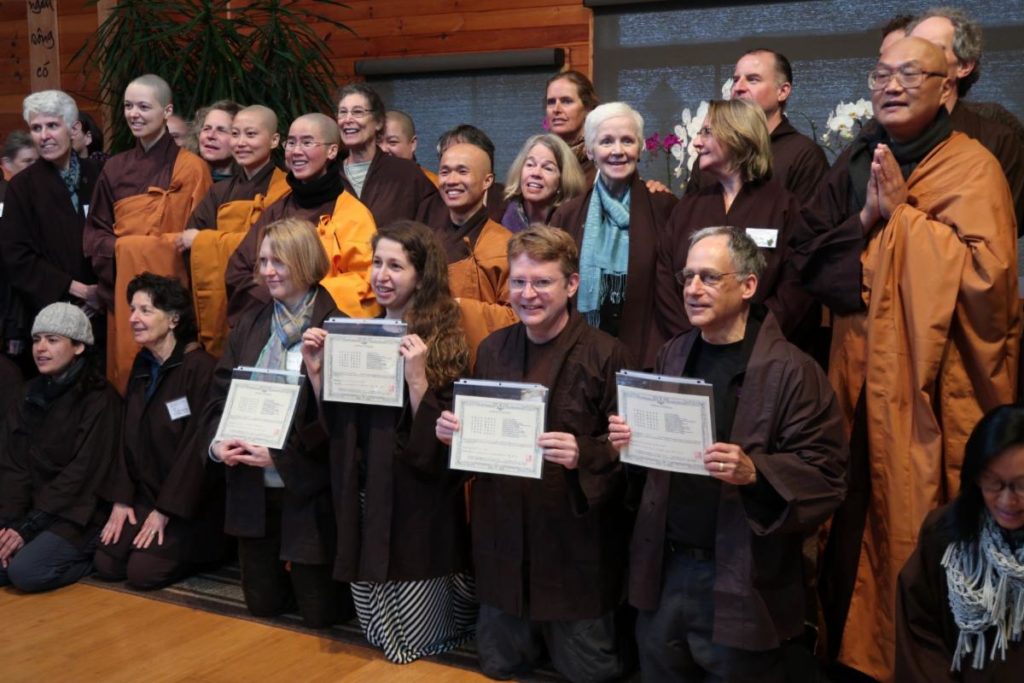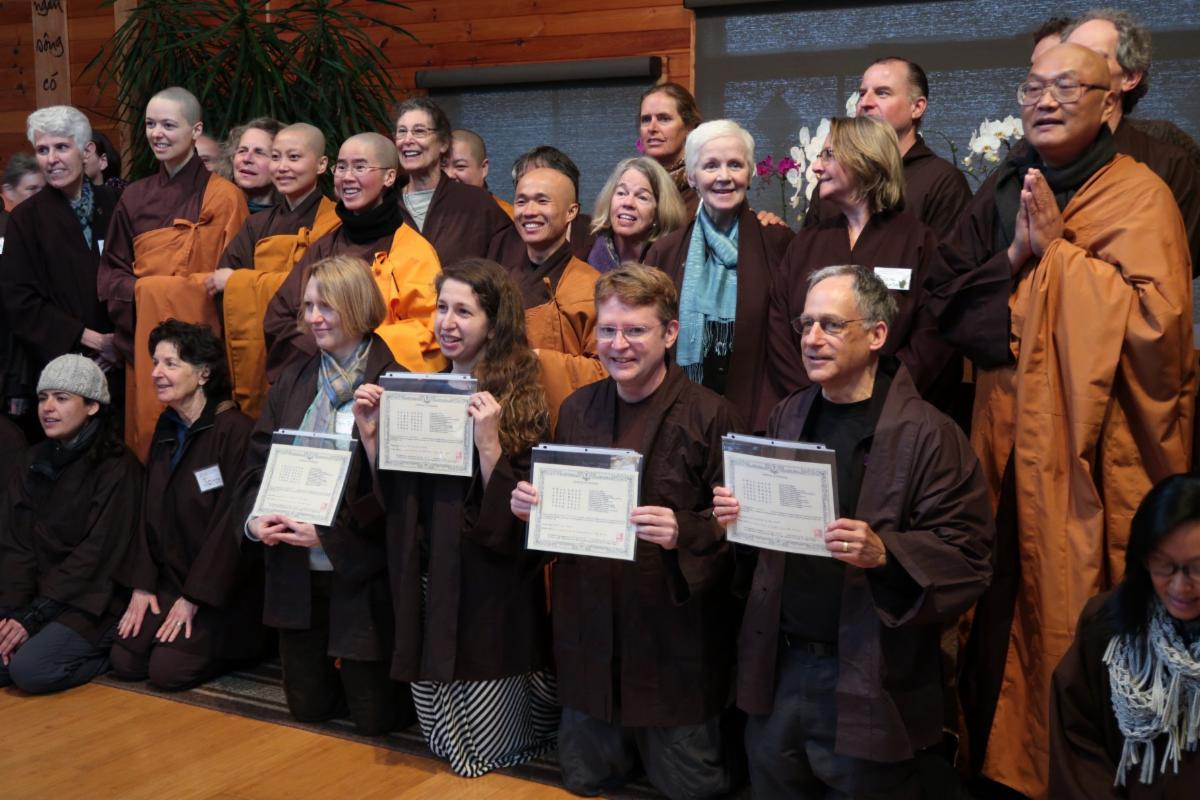Dear Dharma Teachers, Dear Order Members, Dear Aspirants,
In 2021 there will be two opportunities for aspirants from North America to be ordained into the Order of Interbeing. These will be online transmission ceremonies. In order to facilitate the process, please review the requirements, criteria, and procedures for North American students of Thich Nhat Hanh.
The Fourteen Mindfulness Trainings offer clear guidance for living simply, compassionately, and joyfully in our modern world. They are a concrete embodiment of the teachings of the Buddha and the Bodhisattva ideal. Anyone who wishes can live their life in accord with these fourteen trainings.
To formally join the Order of Interbeing means to publicly commit oneself to studying, practicing, and observing the trainings and, also, to participating actively in a community which practices mindfulness in the Plum Village tradition of Thich Nhat Hanh.

The minimum requirements for joining the Order of Interbeing, as established by the Charter of the Order, are that the aspirant:
- Be 18 years of age or older
- Has received the Five Mindfulness Trainings and the Three Jewels
- Practices with a local Sangha in this tradition
- Is committed to observing at least sixty days of mindfulness a year
- Has been mentored by members of the Order of Interbeing for at least a year, and
- Is ready to begin the work of an Order Member: Sangha building and support, explaining the Dharma from personal experience, and nourishing the bodhicitta (the mind of love) in others while maintaining a regular meditation practice in harmony and peace with one’s family.
The process of becoming an aspirant and receiving support and training varies depending on the region and on local circumstances. In a region in which the Order of Interbeing has been established for many years, there may be clearly defined procedures; Dharma Teachers and Order Members available to train and support aspirants; and a community of Order Members that meets regularly for recitation ceremonies, study, and days of mindfulness. In other regions an aspirant may have to travel a considerable distance to practice with an Order Member or Dharma Teacher and the training of aspirants may be much more informal. Nonetheless, the Care-Taking Council and the Dharma Teacher Sangha of North America has developed and adopted an OI aspirant process that is now required in the process of receiving the Fourteen Mindfulness Trainings in North America.
The decision that an aspirant is ready for ordination is a joint decision involving the aspirant, the aspirant’s local sangha, the OI mentors, and one or more lay Dharma Teachers who either have been directly mentoring the aspirant or who have been working with the OI mentors.
It is not possible to specify the exact criteria that determines whether an aspirant is “ripe enough” for ordination – for ultimately it depends on heart-to-heart insight and recognition of a mature Bodhisattva spirit – however, some general guidelines can be stated. To be eligible for ordination into the Order of Interbeing, there is the expectation that the aspirant:
- is a stable practitioner who has learned to transform suffering and embodies the practice of mindfulness in his or her own life,
- practices with a spirit of generosity, attentive to the needs of others,
- is committed to continue deepening his or her practice of the Fourteen Mindfulness Trainings,
- is able to teach the basic practices to others,
- participates (and will continue to participate) regularly and harmoniously in their local practice community and in the Order of Interbeing community, and,
- has the intention and capacity to be an active Sangha builder.
In order to be ordained in 2021, it is requested that the aspirant and their mentors put together a packet containing the following:
- Completed Application to Become an Aspirant to the Order of Interbeing Core Community (this is the application you completed at the beginning of your aspirant training)
- Completed Order of Interbeing Application for North American Applicants.
- For those applying for May 2 ordination, please use this PDF application
- For those applying for the June ordination with Blue Cliff Monastery please use this online application form.
- letters of support from OI mentors and
- letters of support from Dharma Teacher(s)
- letters of support from local Sangha members and family members (when available)
- original letter of aspiration to join the OI (if there is one)
- a letter to Thay articulating the aspirants desire to be ordained into the Order of Interbeing. This letter should include a brief spiritual history and a clear commitment that the aspirant will be a Sangha builder in a community which practices in the Plum Village tradition.
- a copy of the 5 Mindfulness Training certificate, or at least the date, place, teacher of that transmission and the name you received.
- Photo of yourself.
If the aspirant wishes to ordain with Plum Village Practice Center on May 2 at 3:00pm Paris Time, then please email a copy of the items above to Thay Phap Huu at phaphuu@plumvillage.org.
DEADLINE: March 17, 2021
If the aspirant wishes to ordain during the Order of Interbeing Online Retreat hosted by Blue Cliff Monastery between June 24 -27, then please complete the application form and upload the required documents to Dropbox. Questions can be directed to Thay Phap Khoi at phapkhoi@plumvillage.org.
DEADLINE: May 1

